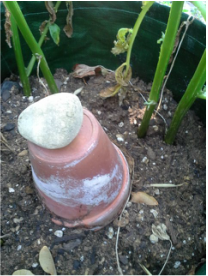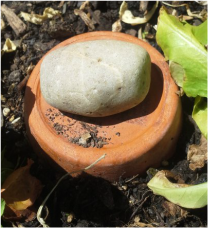I have been experimenting with another type of irrigation this year. Ollas are a type of irrigation that has been around for about 4,000 years. It's an unglazed clay pot that has a wide base and narrow neck. It's buried underground with just the top of the neck showing. Fill it with water and it gently seeps out into the soil as the roots need it. You can buy beautifully made ollas but they are quite easy to make. I made a few this spring and was pleased in how they turned out.
 Half buried olla in my potato pots
Half buried olla in my potato pots Here's what you need to make your own, I adapted mine from the video below:
- 2 unglazed clay pots, they can be different sizes as long as the tops are the same diameter.
- Gorilla glue
- Aquarium grade silicone sealant or other waterproof sealant. I'm always concerned about chemicals leaching out and I felt if this was okay for fish, it was okay for me. Use your own discretion.
- A few rocks or pieces of tile
- Seal up the bottom hole of one pot with the silicone and rock or tile. This is the bottom part of the olla and you don't want to let any water out. I would let it dry and test it before moving onto the next step.
- Put one pot on top of the other and make sure the rims align. If using gorilla glue, dip the rims in water first. Put a small bead of gorilla glue on one rim and align the second on top. I put a weight on it to promote a good seal. Let it dry per product instructions.
- I sealed the outside of the pots where the rims meet with the aquarium grade silicone. Fill in any gaps. Let it dry per product instructions.
- Fill it up and make sure the middle seam is sealed properly.
- Bury in the ground leaving only a little bit exposed. Fill with water and close up watering hole to prevent evaporation and mosquitos. And start planting!
- These are not frost proof so when the temperature drops, empty them out and store them inside to keep them from cracking.
 This is all you should see when properly buried.
This is all you should see when properly buried. - Make watering holes larger, right now I need a small watering can to fill it up and it would be more efficient with the hose.
- Seal the exposed area at the top.
- Look at depth of the beds before buying the pots. Some of mine were too tall when put together.
- Use more, I underestimated how many I would need per raised bed.

 RSS Feed
RSS Feed
